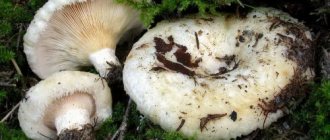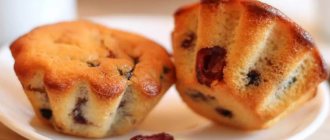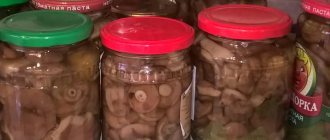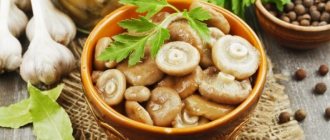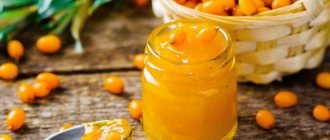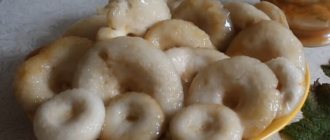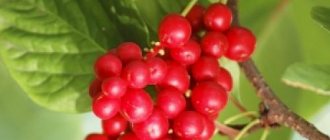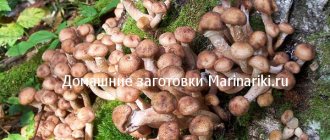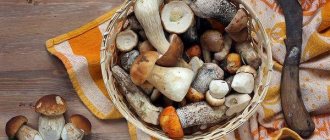Do I need to clean milk mushrooms?
The concept of “cleaning a mushroom” does not always hide the action associated with removing the skin, spore-bearing layer from under the cap and other parts of the fruiting body. To find the correct answer to this question, you need to understand all the nuances. It’s worth starting with the fact that not all milk mushrooms can be eaten. Two types of mushrooms are conditionally edible:
- White milk mushrooms. The color of the growing fruiting body varies from white to slightly bluish. After soaking, the color changes. The mushroom takes on a gray or slightly greenish tint.
- Black milk mushrooms. Despite this name, the caps of the fruiting bodies are dark brown with a greenish tint.
These two species are united by a common habitat. Milk mushrooms grow in families in any forest, but are more often found among pine and birch trees. Fruiting bodies are recognized by their flat cap with a peculiar convexity. It is in this hole that most of the dirt that needs to be cleaned accumulates.
The slimy skin of mushrooms allows dirt, grass particles and leaves to stick to them.
The next thing you need to pay attention to is the skin. In milk mushrooms it is mucous, which promotes abundant adhesion of dust, grass, and pieces of dry leaves. This dirty coating must likewise be cleaned before preparing the fruiting bodies.
Important! In old milk mushrooms, the lamellar spore-bearing layer becomes yellow with brown spots. The skin of the cap darkens and loses its mucousness. This mushroom looks more beautiful in the clearing and is less dirty. However, you cannot add it to your cart.
According to the rules, you need to clean white milk mushrooms or their counterparts with black caps a maximum of 5 hours after collection. You can wait a day, but part of the harvest will be discarded. Such strict requirements are due to the fact that mushrooms contain a lot of moisture in their bodies. Fruit bodies stored for a long time lose their taste, become sluggish, and change the structure of the pulp.
Important! Urban mushroom pickers are more meticulous in cleaning mushrooms. They carefully scrape out the indentation on the cap with a knife and remove the fringe underneath, the same spore-bearing layer. Village residents have the opportunity to collect milk mushrooms in ecologically clean areas. Mushroom pickers limit themselves to soaking with frequent water changes, and do not clean the spore-bearing layer. The next step is to soak the milk mushrooms for 5 hours in cold water and salt them.
Video example of how to clean milk mushrooms quickly:
Collection and preparation for use
Milk mushrooms are white mushrooms with a cap diameter of 5-20 cm. Mushroom pickers are not always able to notice them from under the leaves and dry grass. These mushrooms are collected using a stick. They use it to stir up the forest floor in search of a trophy. Young specimens of small and medium size are considered the most valuable.
Irina Selyutina (Biologist):
Raw or white milk mushrooms are not common, but they always form large families. When searching for these mushrooms, it is important to find at least one and then you will find others. In search of representatives of this species, mushroom pickers inspect clearings in birch groves, as well as the northern slopes of hills and slopes. Fruiting bodies grow from year to year in the same place. The good thing is that worms do not really like milk mushrooms for their milky juice. Compared to the cap, the leg of this species is simply miniature, so it can be quite difficult to see the cap. When arming yourself with a stick to search, you need to take into account the fact that with it you can accidentally damage the cap or, even worse, the mycelium. In the second case, within a few years you will have to forget about the treasured place.
To make your task easier in the future, you begin to process and clean milk mushrooms during the collection period, i.e. already in the forest. To do this, before cleaning, the cut mushroom is inspected for damage by worms. Small ones are carefully trimmed, and for large ones, the entire fungus is removed.
Hidden insects and slugs are removed under the fringe. They also need to be cleaned of debris adhering to the cap and soil at the bottom of the stem.
Milk mushrooms are rarely eaten fried or boiled. This is all due to the bitterness that the milky juice imparts to the finished dish: do not forget that white milk mushrooms are classified as conditionally edible mushrooms. When pickled, mushrooms are valued for their wonderful taste: meatiness, juiciness and unique aroma.
Cleaning milk mushrooms collected in the forest begins with culling those that are not suitable for consumption, that are loose and old. Instances are divided by type: different types will be salted or pickled separately. Then they are washed under running water and soaked for a day. The container with mushrooms is placed in a cool room, the water is changed several times. During this time, all the milky juice comes out.
After the soaking procedure, the milk mushrooms begin to be cleaned. To do this, use a brush with stiff bristles (or a toothbrush), a sponge with a rough surface, or a sharp knife. The mushrooms are carefully scraped until white, cutting off in the process areas that have been damaged by prolonged exposure to water. Then rinse again under running water.
What types of milk mushrooms are there?
In order not to confuse the milk mushroom with its doubles and not throw away the edible mushroom, it is important to know what they are. The most famous ones are white. They are also called real, pepper or wet. They have a very pronounced bitter taste, which is why they must be soaked before cooking and cleaning, as described above. Black milk mushrooms, as the name suggests, have dark caps. In order not to spoil the dish, it is recommended to cook and salt them separately from white ones due to the milky juice and sticky substance with which they are coated. They should be washed especially thoroughly before cleaning.
Not everyone collects dry milk mushrooms. Despite the fact that they are also edible, their appearance repels even experienced mushroom pickers. At the same time, this mushroom is not bitter, being, in fact, one of the types of russula, and not a real milk mushroom.
Features of mushrooms and beneficial properties
White milk mushrooms (real ones) are considered the most delicious for pickles. It has a tubular, outstretched cap, the middle of which becomes depressed with age. The diameter of the cap can reach 20 cm. The flesh of the fruit is white. The milky juice at the cut site acquires a yellow tint.
Black milk mushroom (nigella) has a dark green or yellow-brown round cap. The surface of the cap is moist with the edges curved inward. Sometimes you can see concentric circles on the cap. The pulp is white. Salted mushrooms take on a wine color.
Fleshy milk mushrooms are rich in carbohydrates, proteins and minerals, which are easily absorbed by the human body. It is recommended to include boiled mushrooms in various diets, as they contain a large amount of protein. Breast milk also has other beneficial substances:
- vitamins B and D;
- carotene;
- ascorbic acid;
- phosphorus;
- calcium;
- magnesium.
Consumption of these fruits has a beneficial effect on the nervous system, increases immunity and the performance of hematopoietic organs. In folk medicine, pepper milk is often used to treat kidney and urolithiasis.
How to clean milk mushrooms for pickling
So, you have collected or bought milk mushrooms at the market from trusted mushroom pickers and decided to pickle them. Most often, it is white milk mushrooms with a creamy colored cap. Do not put off mushrooms for “later”; they can wait no more than 5 hours, otherwise they will begin to lose moisture and elasticity.
Here's what to do with them next:
- Sort through, discarding damaged bodies.
- Use your hands to remove large debris - leaves, pine needles, grass.
- Using a knife, scrape off any small debris that has stuck to the cap, paying special attention to the indentation.
- Rinse with running water.
- Soak for a day, changing the water every 5 hours. To prevent the mushrooms from turning sour, add a little salt every time you change the water.
- Wash the mushrooms again by wiping the caps with a soft brush or sponge. If the milk mushrooms grew on sandy soil and there are especially large ones, you can cut off the plates under the cap. A lot of sand accumulates in them and it is sometimes difficult to wash it completely.
Don’t be surprised if soaked white milk mushrooms turn gray or turn a little green - this is their characteristic feature.
Express method for salting milk mushrooms
Don’t want to wait a couple of months for the mushrooms to be salted?
Here is a very quick recipe for pickling mushrooms. Wash the mushrooms, clean them with a stiff brush and put them under pressure, changing the water daily. After three days, take them out, cut them in half and put them in a bucket, sprinkling each layer with salt. Do not use iodized salt. No matter how useful it is, it turns the mushrooms black. Place the mushrooms under pressure for three days, stirring them occasionally. Afterwards, they can be placed in pre-sterilized jars and placed in the refrigerator under a nylon lid.
Milk mushrooms for the winter: secrets and features of preparing the product
If you ask any mushroom picker how to properly process and preserve milk mushrooms for the winter, you will certainly receive a complete dossier on such mushrooms and a lot of other useful information. The fact is that they have always been in honor of the Russian people since the time of Ancient Rus'. They were used to cook aromatic soups, make savory pickles, and tender pies. Many traditions of that time have survived to this day. In this article you can take a closer look at these delicious mushrooms and how to process them.
How to process milk mushrooms after harvesting
When the harvest is delivered home, you can’t wait too long. You need to immediately start preparing everything you need to help you clean the fruiting bodies efficiently. To complete the procedure you need:
- The round container is larger in volume than mushrooms. A saucepan, basin, bucket or plastic barrel will do. If there is too much harvest, several containers will be needed.
- Cold water is needed, preferably running water. If there is no running water, you can use a well. In the second option, you will often have to change the water manually using buckets.
- A knife with a sharp blade is necessary for trimming the lower part of the stem, damaged areas, and will help better clean dirt from the cap.
- A brush with soft bristles or a regular sponge is used when washing mushrooms. Cleaning with a device with rough bristles is unacceptable. It will damage the fruiting body.
When everything is prepared, an important moment begins - processing the milk mushrooms before cooking or salting.
How to quickly clean milk mushrooms from dirt
The harvest delivered from the forest must be cleaned, but first it is subjected to pre-treatment. First of all, sort out all the mushrooms. Old milk mushrooms, damaged by slugs or worms, and questionable fruiting bodies are thrown away. If the damage is minor, you can cut it with a knife. The sorted mushrooms are cleaned by hand from large debris. If necessary, clean the surface of the cap with a knife, scraping off adhering leaves and grass.
It is convenient to clean dirt from the surface of the cap with a knife.
After completing the “rough” cleaning, the milk mushrooms are washed with running water. It is optimal to load them in portions into a colander and place them under the water tap. The washed fruiting bodies are placed in a container and filled with cold water for 3 hours. During this time, the adhered dirt will fall off. Heavily soiled caps are cleaned with a brush.
Dirty water is drained, after which a new portion is immediately poured. To prevent milk mushrooms from floating, cover them with a large dish or lid and place a load on top, for example, a jar of water. Soaked mushrooms last for a day. During this time, the fine dirt that has eaten into the body of the milk mushrooms will fall away, and the insects will die. During the day, the water will have to be changed every 4-5 hours. If this is not done, the fruiting bodies will turn sour.
Advice! So that during soaking the milk mushrooms do not lose their taste, add 1 tbsp to 6 liters of water. l. salt or citric acid.
How to quickly wash milk mushrooms
After a day of soaking, the main dirt will fall off. The water is drained from the container. To further properly clean milk mushrooms after soaking, arm yourself with a brush or sponge. The washing process begins. Mushrooms are filled with clean cold water. Each cap is cleaned by rubbing in a circular motion with a brush or sponge. Cleaning the cap from the spore-bearing layer is a controversial matter. Usually sand accumulates between the plates, which is difficult to remove even by soaking. If the harvest was carried out in the forest on sandy soil, then it is better to cut out the spore-bearing layer with a knife. Rural residents who collect milk mushrooms in ecologically clean, non-sandy areas do not do this.
To wash mushrooms you will need a large container, such as a bucket.
Advice! To easily clean large milk mushrooms, cut them into 2-3 parts.
The processed mushrooms are washed again and placed in another container with clean salted water. Here they have to get wet for another day. The next day they are simply washed under running water, no longer cleaned, and used for cooking.
Cold salting method
It takes much longer than the hot version, but it is somewhat simpler.
The milk mushrooms are cleaned of dirt, sticks, twigs, washed under running water and placed to soak. After the required time has passed, the mushrooms are cleaned using a stiff brush or sponge with a hard cleaning surface.
After this they are cut into pieces. The ideal option for cold pickling is slicing. This is easy to do if you cut the mushroom into triangles, starting from the cap.
Sliced mushrooms are poured with water and placed under pressure. The main thing is to optimally select the weight of the oppression so as not to simply crush the mushrooms.
The mushrooms should be soaked for about a week. To prevent water from stagnating and spoiling, it must be changed daily.
When a week has passed, the water needs to be drained and the mushrooms inspected. If necessary, all damaged areas are trimmed.
The mushrooms are then washed again and covered with salt. Iodized salt, despite all its usefulness, is better not to use. Mushrooms may turn black and lose their attractive appearance, although their taste will not be affected.
Mix again and put under heavy pressure. Stir occasionally, as the milk mushrooms will release juice during the pickling process.
After three days, mix the mushrooms again. Mushrooms are tightly packed into sterilized jars and filled with brine. There is no need to seal the jars, but you can simply close them with plastic lids and put them in the refrigerator.
A simple solution to remove iodine stains from clothes
When a lot of caustic substance gets on the skin, only quick action will help to avoid a burn.
If the spot is brown or blisters appear, it means the skin is burned.
It is urgent to remove the iodine that has not had time to be absorbed with boiled warm water. This needs to be done for a long time, from 10 minutes to half an hour, depending on the time of the burn. Iodine burns are eliminated with neutralizing substances:
- crushed chalk;
- tooth powder;
- soap solution;
- 20% sugar syrup.
It is forbidden:
- treat the wound with potassium permanganate or alcohol;
- rub, pierce blisters;
- apply ice.
Apply compresses until complete healing:
- with drunken tea;
- with grated raw potatoes;
- with St. John's wort or sea buckthorn oil.
We invite you to familiarize yourself with the Shelf life of food products according to Sanitary Regulations
The mixture is wrapped in gauze and kept on the wound, without covering anything on top.
You can treat iodine burns with oatmeal porridge, applying it as a compress.
However, in case of extensive or severe damage, especially if a child received a burn, it is necessary to consult a doctor and be treated under the supervision of a specialist.
For fabrics, ready-made stain removers are effective and easy to use, the composition of which allows you to eliminate iodine stains. In this case, simply follow the instructions.
The remedies that are always at hand are also effective.
Ammonia
- water - glass;
- ammonia - 5 drops.
Starch
Mix concentrated dishwashing detergent with potato starch.
Keep the paste until it dries, replacing it with a new one until the stain disappears.
Simply rubbing dry starch into a stain moistened with water will also help; as soon as the starch turns blue, it needs to be replaced.
You can grate raw potatoes and hold them on a cloth for 15 minutes.
Old iodine stains can also be removed with starch, but in this case the paste is left on the fabric for at least 12 hours.
Laundry soap
Lather the clothes thickly and leave to sit for at least 30 minutes.
Baking soda
- cover the stain;
- extinguish with vinegar;
- leave overnight;
- rinse.
Liquid acid is used undiluted, the tablets are dissolved in water. Simply pour onto the stain and rub with a clean cloth.
Sodium thiosulfate
Iodine dissolves well, but before using it, you need to check the fading resistance of the fabric.
After using any method, the item is washed in the usual way.
When removing iodine stains, you need to use gentle methods first, repeating if necessary, and only then more aggressive ones.
There is no need to rush too much: it is better to see that the stain has evaporated on its own over time than to ruin the thing by frantically trying to wipe off the orange mark.
Preparation
Before processing milk mushrooms, certain stages of preparation for this process are performed.
First of all, all collected milk mushrooms should be cleared of debris, sand, stuck leaves and needles from the forest.
It is necessary to mercilessly remove rotten or wormy specimens, mushrooms that have a loose structure or are damaged by slugs and insects.
Next, all the mushrooms need to be sorted by size. Some will be used for drying, others for salting or cooking.
Then you need to carefully inspect all sorted mushrooms for damage.
It is advisable to cut out damaged or suspicious places, and you also need to trim the lower part of the leg again.
It is worth cleaning the underside of the cap. A pointed knife with a small blade is suitable for this. If the mushroom is large, it can be cut in half. This makes it easier to clean it from dirt and remove the spore-bearing layer.
The peculiarity of processing milk mushrooms is that they contain the so-called white “milk” - milky juice, which adds bitterness to ready-made dishes. Most of it is in the hat and plates.
Distribution and collection features
The distribution areas of milk mushrooms are deciduous or mixed forests: birch, birch-pine, with linden undergrowth. The comfortable soil temperature required for their growth and reproduction is from +8 to +11°C. Therefore, they are practically not found in the south of Russia and Europe, preferring the northern regions of the temperate climate zone.
Milk mushrooms grow in July - September . If the weather is warm and rainy, they can occur in early October. They don’t like heavy rains; mushrooms quickly deteriorate after it. They also do not like long dry weather, but appear after a long drizzling “mushroom” rain. Milk mushrooms grow in large groups. If one mushroom is found, a whole family of them is sure to nest somewhere nearby, camouflaged by a dense cover of fallen leaves or pine needles.
Adult milk mushrooms can reach enormous sizes . The cap, with a diameter of 5 to 20 cm, looks like a funnel on top and has a wet surface. The stem is cylindrical, smooth, its height is up to 8 cm, its diameter is up to 5 cm. The color of the cap depends on the type of mushroom. It can be yellow, white and even black. When broken, it releases a caustic white juice, which, when exposed to air, quickly acquires a sulfur-yellow color. At the bottom, the cap consists of white wide plates.
Not all milk mushrooms are edible. Particularly dangerous is the camphor milk mushroom , or camphor milkweed, which can cause severe poisoning if it accidentally ends up in a basket. Its special characteristics: a brown cap with sparse yellow plates, the place where it breaks immediately darkens. But, fortunately, it is rare.
Features of cleaning black milk mushrooms
This type of mushroom is easily recognized by the characteristic color of the cap. It is a beautiful brown color, and in the sun it has a swamp-green tint. Black milk mushrooms are considered a delicacy, and their processing is slightly different. You will also need to wash these royal mushrooms well from debris, cleaning the caps with a knife if necessary. But there are some nuances regarding soaking. Mushrooms need this procedure to get rid of bitterness. At the same time, it is believed that prolonged exposure to water contributes to the deterioration of their taste characteristics.
With black milk mushrooms, follow the “golden mean”: soak them in cold water, but do not keep them for more than 3 hours. This time is quite enough for the blades of grass to fall behind, the bitterness to come out, but the taste does not change. Don't forget to salt the water.
How to dry for the winter
IMPORTANT! Milk mushrooms belong to the lamellar mushrooms (like honey mushrooms, saffron milk caps, russula), and they are dried extremely rarely. With this method of processing, very little of the final product comes out. The bitterness characteristic of fresh milk mushrooms does not go away after drying, and when preparing dishes, mushrooms prepared in this way will have to be soaked for a long time.
You should adhere to the following rules:
- mushrooms intended for drying are not washed or soaked. More than you can get by, wipe the milk mushrooms with a slightly damp cloth. It is best to simply scrape the stem and cap with a knife to remove debris;
- Use only strong and resilient specimens. Do not dry wormy specimens under any circumstances;
- If the mushrooms are dried whole, they need to be sorted by size or cut into equal pieces so that the dehydration process occurs evenly.
Delicious recipe! Lenten apple pie with yeast
In urban conditions, the most acceptable options for drying mushrooms are an oven and an electric dryer. When using the oven, place the mushrooms on a wire rack or parchment-lined baking sheet so that they do not touch each other. Set the temperature from 45 to 70 degrees. Ideally, the oven has an air convection function. If not, the door can be opened slightly to the width of your palm.
During the process, the milk mushrooms should be stirred periodically. The time varies depending on the size of the fruiting bodies and the set temperature. Readiness is determined as follows: mushrooms should bend, but not break, be elastic and dense to the touch, but not moist.
How to process white milk mushroom before drying
Before processing white milk mushrooms before drying, you need to remove all forest debris and sort the raw materials by size. Mushrooms are not washed before drying. The rule common to all drying methods is that the mushrooms are dried for 2–3 hours at a temperature of +40–50 °C to evaporate the main amount of moisture. Then the mushrooms are dried at a temperature of +70–80 °C. After drying for several hours in the shade, the mushrooms are dried in the sun. You cannot dry them in ovens, as they easily burn. Mushrooms should be dry to the touch, slightly bendable and break easily. The top of the cap is yellowish or brown in different shades: dark brown in white milk mushrooms and from yellow-brown to black in black ones. Store dried mushrooms in dry, well-ventilated areas, on racks in packaged form or hanging in bundles. It is unacceptable to store dried mushrooms together with salted and pickled mushrooms, with fragrant herbs and wet foods. If the mushrooms are damp or moldy, they must be sorted and dried, removing the spoiled ones.
Methods for salting milk mushrooms for the winter at home
There are two ways to pickle mushrooms for the winter: cold and hot. Among the variety of recipes, every housewife is sure to find the most suitable one for herself.
Hot
Hot salting will take much less time from the housewife than cold salting. It is used when there are no suitable conditions for prolonged soaking of fruits. For this method you will need to boil the milk mushrooms.
- The washed fruits are left in a colander to get rid of excess water.
- Add 1 tbsp to a clean saucepan per 1 liter of water. l. salt, 20 black peppercorns, 10 allspice peas, 2-3 cloves, several bay leaves.
Preparing mushrooms
- You need to select a large container for the brine, because it is in it that the milk mushrooms will be salted.
- After the brine boils, add the boiled fruits to the pan and boil for 10-15 minutes.
- Remove the container from the heat and add horseradish root and a few cloves of garlic to taste.
Salting process - It is necessary to place a load on top so that the fruiting bodies are completely covered with brine and are not in contact with air.
- The pan is transferred to a cool place and left there for a week.
- After this time, the fruits are placed in sterile jars and filled with brine.
- Sunflower oil must be added to each jar to prevent air from entering, after which the containers are tightly closed with lids.
Hot-salted milk mushrooms Containers with mushroom mass are transferred to a cool place for about 40 days. After 1-1.5 months, the dish will be ready.Cold
Cold salting requires long soaking, because this method eliminates cooking. It will not be possible to cook the fruits quickly, because soaking should last 72 hours. To prepare 5 kg of milk mushrooms you will need the following ingredients:
- 500 g salt;
dill umbrellas;
cherry, currant and horseradish leaves; fresh garlic.
To begin with, the harvested crop is cleared of debris and washed well. Pour cold water over the clean fruits, press the lid on top and place them in the cellar for three days. During soaking, the water must be changed 2-3 times a day. After soaking, start salting:
- The soaked mushrooms are sprinkled with salt and placed in layers in a container with the caps facing down.
- Each layer is covered with leaves, dill and chopped garlic.
- Cover the filled container with a cloth and lay out the rest of the greens.
- A suitable load is placed on top and the container is taken to the cellar for a month.
The temperature of the room in which the pickles will be stored should be below 16˚C. You will be able to try mushrooms in two months.
In a barrel
To pickle a forest harvest in a wooden barrel, prepare the following ingredients:
- 1 kg of boiled mushrooms;
- 50 g table salt;
- currant and horseradish leaves;
- spices are added to taste.
The peeled fruiting bodies are soaked for 24 hours, not forgetting to add a little salt to the water first. During this time, you should change the water twice. The soaked milk mushrooms are washed and thrown into boiling water. After boiling, boil for about 5 minutes and drain in a colander. The mushroom mixture should be placed in a barrel in layers, sprinkling each layer with salt, spices and leaves. The last layer is covered with gauze and oppression is installed.
With spices
To salt 5 kg of mushrooms, prepare the following ingredients:
- 200 g table salt;
- 10 leaves of black currant and cherry;
- 5 sprigs of dill;
- 5 horseradish leaves;
- 10 peas each of black and allspice;
- 5 bay leaves.
The bottom of a deep container is covered with leaves and several sprigs of dill. The prepared fruits are laid out in layers of about 10 cm. Each layer is generously sprinkled with a mixture of spices. The filled container is covered with a layer of leaves on top and heavy oppression is installed. You can taste the dish after 1.5 months.
In cabbage leaves
To prepare milk mushrooms according to this recipe, you will need to soak the fruit for two days. After soaking, prepare the following ingredients:
- 5 kg of mushrooms;
- 5 liters of water;
- 300 g table salt;
- 100 g fresh dill;
- 20 leaves of currant and cherry;
- 10 cabbage leaves;
- 1 head of garlic.
Each clove of garlic is cut into two or three parts. The dill is washed and finely chopped. Mushrooms are placed in a container in layers, each of which is covered with cabbage, cherry and currant leaves. Then sprinkle with salt, garlic and dill. They put oppression on top and take it to the cellar for 60 days.
Hot salting method
Mushrooms are most often salted hot, and milk mushrooms are no exception.
After preliminary preparation, when they are soaked, dried and properly cleaned, they are placed in an enamel container and boiled for about half an hour. Then the mushrooms are taken out of the water and laid out on a wide dish. It is better not to pour out the broth. If the mushrooms have been previously prepared and cleaned properly, then the broth is edible. It adds incredible flavor to any sauce or soup. In a separate bowl, prepare the brine in the proportion of 1 liter of water: 2 tbsp. l. salt, black and allspice, other seasonings.
Milk mushrooms are boiled in boiling brine for about half an hour. Add horseradish and garlic there.
Afterwards they are put under oppression. They cover the top with a plate, and some kind of pressure is placed on it. The easiest way is to put a jar of water. The mushrooms will begin to release water, which will eventually cover them. If little water has been released, add the brine in which they were boiled.
The mushrooms remain under pressure for about a month, and then they are put into jars. You can cover with cabbage leaves and place under nylon covers.
Frying dry milk mushrooms
There is nothing tastier than fried dry milk mushrooms. Before frying, it is better to boil them so that they become softer. But before cooking they need to be cleaned. Despite the fact that dry milk mushrooms are not covered with mucus, they also absorb all the most harmful things from the environment, accumulating it all in the skin. Mushrooms are cleaned as follows. Take an old toothbrush or just a hard sponge and use it to remove the top skin. Then boil the mushrooms and start frying. It is better to add finely chopped onion, so the dish will acquire an additional flavor. Salt, pepper, serve with herbs.
What can you do with milk mushrooms after salting them for the winter?
What to do with milk mushrooms not only for the winter? There is also a huge selection for every housewife. For example, these mushrooms make a delicious soup. You can also fry them with potatoes or sour cream, make julienne or caviar for filling in the dough. Milk mushrooms make excellent pates and sauces. But special attention is paid to dishes made from salted milk mushrooms. What can you do with milk mushrooms after salting? The most common option is as follows: the mushrooms are soaked from salt for about 2 hours, allowed to drain, and then seasoned with vegetable oil, vinegar, green or onions.
You can add fresh dill or parsley. Many housewives combine such mushrooms with carrots in Korean and it turns out to be an excellent appetizer with a glass of forty degrees.
In addition, after soaking from salt, salted milk mushrooms are cut into pieces and added to various salads, seasoned with mayonnaise or sour cream. They go well with chicken, fresh vegetables, crab sticks, legumes, and boiled eggs.
What can you do with salted milk mushrooms and a recipe for leg caviar
What else can you do with salted milk mushrooms? It turns out that you can fry them with onions and potatoes and even make a delicious French appetizer - julienne.
Many housewives pickle only the caps of the fruiting bodies and remove the stems. In this regard, the question arises: what can be done with the legs of milk mushrooms? For example, you can cook delicious caviar.
To do this, you need to grind the boiled legs in a meat grinder. And then, adding chopped vegetables and spices to taste, simmer the mixture over low heat for 30 minutes.
What to do if jars of milk mushrooms explode immediately after preservation?
There are situations when the lids on preparations with mushrooms are torn off, why does this happen? There are several reasons for this:
- poor primary processing of fruit bodies, which includes cleaning, soaking and boiling;
- poor sterilization of cans, as well as improper sealing of them, as a result of which air can enter and the can will swell;
- failure to follow the exact recipe, usually due to an insufficient amount of vinegar in the preparation;
- non-compliance with the rules for storing jars with blanks.
But what to do if the jars of milk mushrooms exploded? It is best to throw them away and not endanger your health. However, if such an unpleasant situation occurred only a few hours after preservation, then the workpiece can be saved. Sterilize new jars, boil the contents well, then roll them up again and let them cool. Take it to the basement or leave it in the refrigerator.
Construction and repair, mushrooms and fishing, home economics and health
First aid for botulism
Botulism leads to general poisoning of the body, the disease develops very quickly. Within a few hours after eating food containing the toxin, weakness, dizziness, and loss of visual acuity occur. A person suffers from pain in the stomach area and feels ill. The victim must be urgently taken to the hospital. And as first aid, you should undertake the most vigorous lavage of the stomach and intestines with a 5% solution of baking soda, use radical laxatives and enemas. To avoid this serious disease, you must adhere to one more rule: do not buy salted or pickled mushrooms on the market from private traders. You should eat only home-cooked mushrooms when you are absolutely sure that they are all edible, carefully processed, salted or pickled in compliance with preventive measures against botulism, stored in proper conditions and with systematic care (removing mold, digesting marinades if necessary, etc.) . P.).
Watch how to process milk mushrooms in the video, which provides advice from experienced chefs on how to cook mushrooms.
Without delaying
Mushroom pickers know that preliminary cleaning of mushrooms must be done in the forest. Even if you are a supporter of picking mushrooms by twisting them out of the mycelium, take a knife with you into the forest. It is useful for pre-processing the crop.
Preliminary cleaning and sorting of mushrooms must be carried out in the forest
Instructions:
- Before putting the mushroom in the basket, remove any remaining soil, adhering twigs, leaves and needles from it.
- Remove the worm pulp, otherwise the worms will damage neighboring mushrooms.
- Get rid of poisonous and simply questionable mushrooms. It’s better to throw away ten dubious ones than to have one poisonous one end up in your basket.
- For mature mushrooms with a loose sponge, it is better to remove it on the spot; anyway, you will have to throw it away later. And once in the basket, the sponge tubes can tightly stick to the caps of neighboring mushrooms and will add problems to you during subsequent cleaning.
- It is better to throw away old and rotten mushrooms on the spot. Their taste and aroma leave much to be desired, and a shapeless, slippery mass instead of a mushroom can survive until processing.
Processing in the forest can be limited to this; the rest of the work is done at home.
Is a water change necessary?
Before the main cleaning, milk mushrooms must be soaked in water, otherwise they will become bitter later.
Before the main cleaning, milk mushrooms must be soaked, otherwise they will taste bitter. Therefore, during the day it is necessary to change the water at least 5 times, and preferably every 3-4 hours.
If you increase the time between water changes, the milk mushrooms may turn sour. The water should always be cold.
Before draining the water from the container, you need to rinse the milk mushrooms in a circular motion.
Then, holding the lid, drain the water so that the mushrooms do not fall out. Pour clean water and cover with a lid with a weight.
Filled milk mushrooms should stand in a dark and cool place.
Do not use warm or hot water, as the mushrooms will become soft and unsuitable for further cleaning. If you start cleaning such a mushroom, it will break and crumble.
Preparation and processing of milk mushrooms
To properly pickle mushrooms at home, they should be pre-processed and prepared for pickling. To begin with, they carefully sort out and discard damaged and wormy fruits. If a small area of the fruiting body is affected, it can be trimmed down to healthy pulp, and forest debris can also be removed. The most dirty mushrooms can be cleaned with a soft brush. If the dirt is firmly ingrained, then such fruits are soaked for several hours.
After cleaning, the mushrooms are washed well and cut according to the recipe. When salting the caps themselves, it is better not to throw away the stems, but to prepare mushroom caviar.
The next step in preparation for salting is soaking. You should not forget about it, because otherwise the milk mushrooms will taste bitter. The forest crop must be completely immersed in cold water. The fruits will float to the surface, but they can be pressed down with a lid and a small weight. The milk mushrooms are soaked for three days, during which the water should be changed twice a day.
Soaking mushrooms
The soaked mushrooms are thoroughly washed 3-4 times. If there are few fruits, then it is advisable to thoroughly rinse each mushroom.
How to pickle milk mushrooms
Hello dear mushroom lovers.
How to properly pickle milk mushrooms - today I looked at the Internet with this question and gasped!
Here's the recipe! And on all resources on the first search page - like a carbon copy.
Let's pickle the milk mushrooms correctly so that you can then enjoy their unique taste, and not use something like multi-frutti collected from different flavor aromas.
Let me make a reservation right away that the so-called hot salting method is immediately discarded. No heat treatment is required for milk mushrooms. It's possible, but it won't be the same.
How to process dry milk mushrooms
The value of milk mushrooms lies in their flavor and aromatic substances, which determines the widespread use of mushrooms in the preparation of various dishes, as well as sauces and soups. It is customary to sort dried mushrooms, wash them in 3-4 waters and soak them in cold water. Salted and pickled milk mushrooms are also sorted and, if necessary, cut. Salted milk mushrooms must be kept in brine before processing, otherwise their taste and appearance will deteriorate.
Before processing dry milk mushrooms, you need to soak them to swell.
